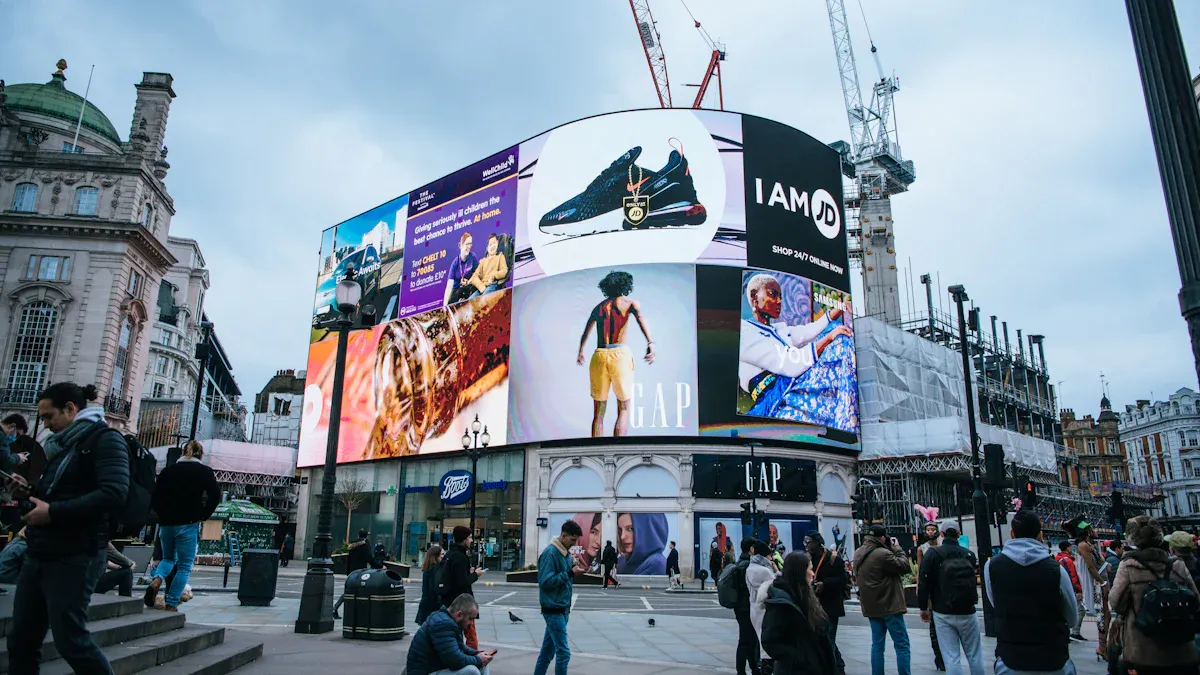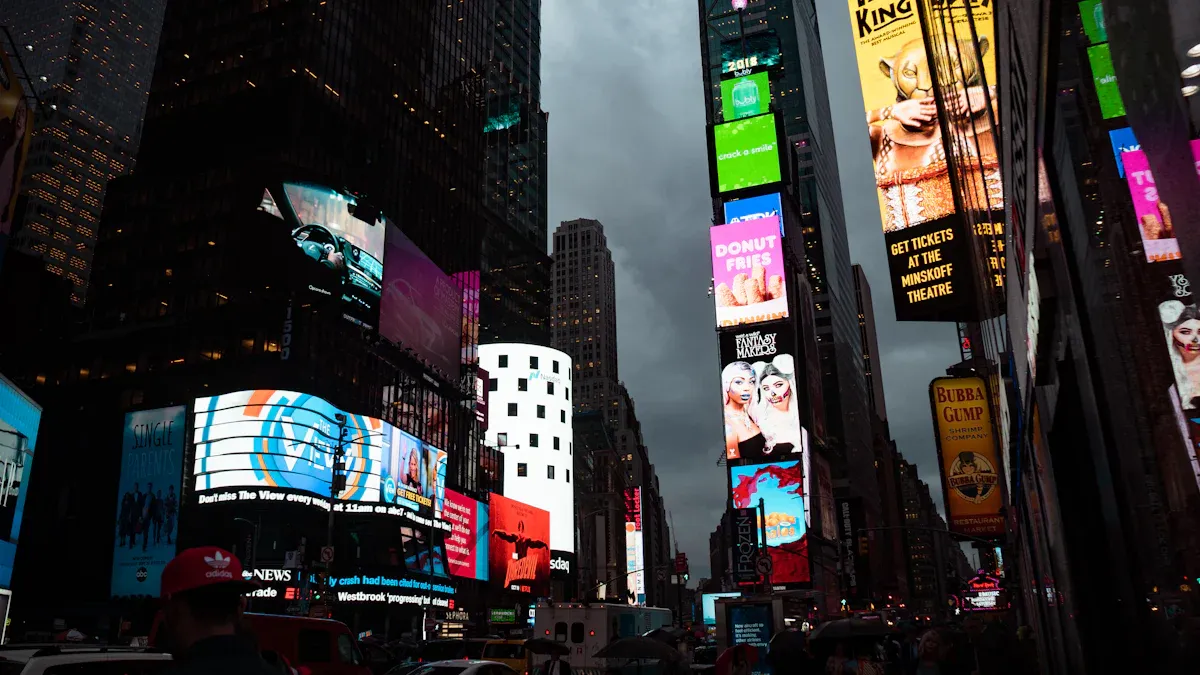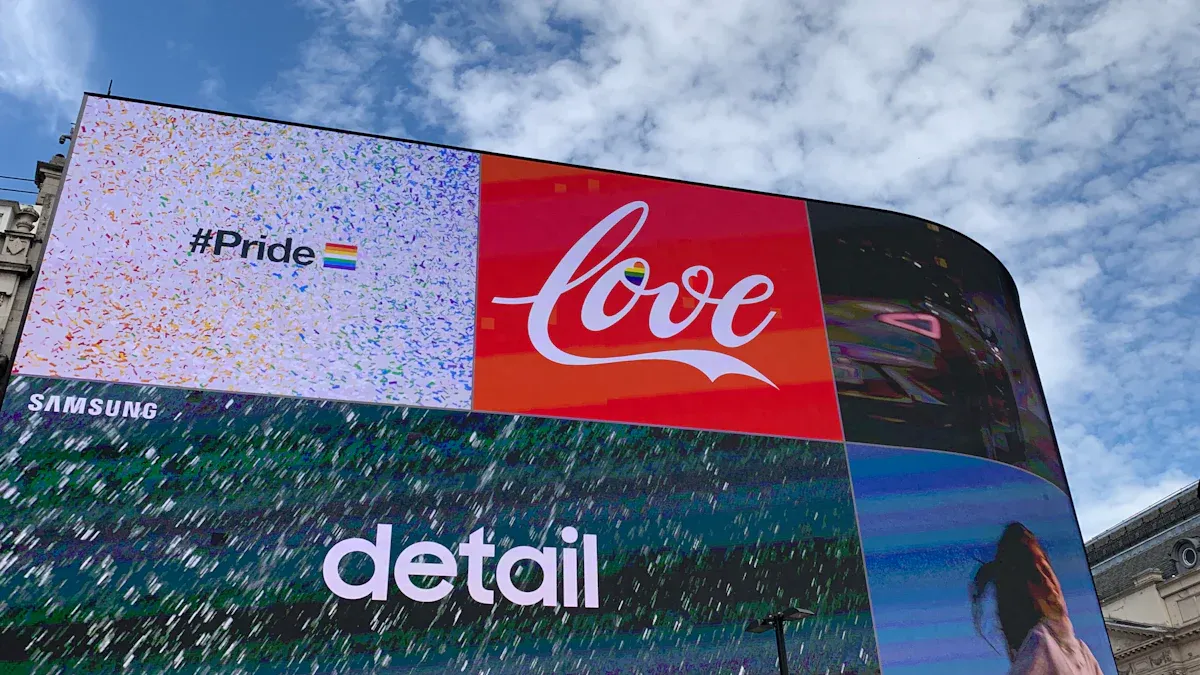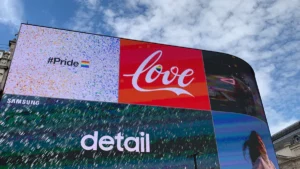For information about how Screenfluence can help your business with digital signage, please don’t hesitate to contact us by calling 1-844-772-7336 or emailing info@screenfluence.com.
Contact UsThe Role of Digital Signage in Marketing
Enhancing Brand Visibility with Digital Signage
Digital signage has revolutionized how businesses enhance brand visibility. Unlike static advertisements, digital displays grab attention with vibrant colors, dynamic graphics, and motion. These features make your brand stand out in crowded spaces. For instance, McDonald’s successfully transitioned to digital menu boards, showcasing promotions and menu items more effectively. This approach not only improved customer experience but also reinforced their brand identity across locations.
Statistics show that 83% of consumers recall messages from digital signage, and 71% find it more noticeable than online ads. These numbers highlight its power to leave a lasting impression. By tailoring messages to specific audiences and contexts, you can ensure your brand remains relevant and memorable. Whether you’re promoting a product or building awareness, digital signage offers unmatched adaptability and consistency.
Driving Audience Engagement Through Dynamic Displays
Dynamic displays do more than just inform—they captivate. By incorporating interactive elements like touchscreens or motion sensors, you can transform passive viewers into active participants. This level of customer engagement fosters stronger connections with your brand. For example, Lay’s UEFA Champions League campaign used interactive digital signage to engage fans with features like the “Chip Cam” and QR codes.
Dynamic content also improves message retention. The brain naturally responds to novelty, making moving visuals and real-time updates more impactful than static ads. With digital signage, you can update content instantly to reflect current events, promotions, or customer preferences. This agility keeps your audience engaged and your messaging fresh.
Measuring ROI with Digital Signage Campaigns
To maximize the impact of your digital signage campaigns, measuring ROI is crucial. Metrics like foot traffic, dwell time, and engagement rates provide valuable insights into how well your displays perform. For example, tracking dwell time can reveal how long customers interact with your signage, often correlating with increased purchasing behavior.
Digital signage also offers tools like analytics software and heatmaps to refine your strategy. These tools help you identify what works and what doesn’t, ensuring your campaigns remain cost-effective. Compared to traditional marketing, digital signage delivers higher long-term ROI due to its adaptability and measurable results. By leveraging these insights, you can optimize your campaigns and achieve your marketing goals.
Building an Effective Digital Signage Strategy

Understanding Your Target Audience
To create a successful signage strategy, you must first know your audience. Understanding their demographics, such as age and gender, allows you to tailor your digital signage content effectively. For example:
- Younger audiences may respond better to vibrant visuals and interactive features.
- Older demographics might prefer clear, straightforward messaging.
Gathering accurate data about your target audience is easier than ever. Use tools like sensors, cameras, and digital signage software to collect viewer demographics and engagement rates. Analytics software can help you interpret this data, ensuring your content delivery aligns with audience preferences. By knowing your audience, you can craft messages that resonate and drive engagement.
Crafting Engaging and Relevant Content
Content is the heart of any digital signage marketing strategy. To capture attention, use easy-to-read fonts and colors that align with your brand identity. Incorporate multimedia elements like videos and animations to make your digital displays stand out. Here are some best practices:
- Experiment with different formats to see what works best for your audience.
- Regularly update content to keep it fresh and relevant, especially for repeat viewers.
- Use contrasting colors to enhance readability and visibility.
Personalization also plays a key role. Tailored messages not only strengthen brand-consumer relationships but also drive conversions. For instance, displaying time-sensitive promotions based on customer behavior can significantly boost sales.
Selecting the Right Technology for Digital Signage
Choosing the right technology is crucial for an effective digital signage strategy. Modern advancements like AI and machine learning enable real-time content adaptation based on viewer preferences. Immersive technologies such as AR and VR create engaging experiences that captivate audiences. Additionally, sustainable solutions like energy-efficient displays are gaining popularity.
When evaluating cost-effectiveness, consider both initial investments and ongoing expenses. While digital signage may have higher upfront costs compared to traditional signs, its ability to increase brand awareness by up to 47.7% and sales by 29.5% makes it a worthwhile investment. Use digital signage software to manage content updates efficiently and maximize ROI.
Strategic Placement of Digital Displays
The placement of your digital displays can make or break your campaign. High-traffic areas like entrances, waiting rooms, and checkout counters are ideal for maximizing visibility. Consider the flow of traffic in your space to ensure optimal placement.
Timing also matters. Schedule content delivery based on the time of day and audience context. For example, display time-sensitive promotions during peak hours to capture more attention. Digital signage systems with scheduling features allow you to automate this process, ensuring your messaging reaches the right audience at the right time.
Pro Tip: Strategic placement not only boosts engagement but also enhances the overall customer experience, making your digital signage marketing strategy more effective.
Advanced Digital Signage Marketing Strategies
Integrating Digital Signage with Other Marketing Channels
Integrating digital signage with your existing marketing channels creates a seamless and cohesive brand experience. By coordinating visuals and messaging across platforms, you ensure consistency that resonates with your audience. For example:
- Adidas combined digital signage with interactive mirrors and social media integration to showcase products and promotions in real time.
- Sephora used in-store digital screens to provide personalized recommendations and augmented reality mirrors for virtual try-ons.
You can also enhance engagement by linking digital signage with WhatsApp marketing or email campaigns. This approach bridges the gap between online and offline interactions, creating a unified customer journey. To achieve this, focus on strategic placement and staff training. A well-trained team ensures smooth integration, while strategic placement maximizes visibility and impact.
| Strategy | Description |
|---|---|
| Integration with broader marketing | Enhances effectiveness through staff training and audience understanding. |
| Coordination across platforms | Boosts effectiveness by aligning visuals and messaging. |
| Strategic placement | Engages customers by bridging online and in-store experiences. |
Leveraging Interactivity to Boost Engagement
Interactive digital signage transforms passive viewers into active participants. Features like touchscreens, gamification, and quizzes encourage engagement and leave a lasting impression. For instance, the “No Lay’s, No Game” campaign during UEFA Champions League matches allowed fans to interact with soccer legends through a “Chip Cam” and QR codes. This creative use of interactivity captivated audiences and strengthened brand loyalty.
You can also use gamification elements like spin-to-win wheels or trivia challenges to keep customers engaged. Interactive LED displays that respond to user input offer personalized experiences, adding value beyond traditional advertising. These features not only boost engagement but also encourage repeat visits and social media sharing.
Pro Tip: Incorporate rewards systems or social media challenges to incentivize participation and amplify your campaign’s reach.
Using Data Analytics to Optimize Campaigns
Data analytics is essential for refining your digital signage campaigns. Metrics like audience engagement levels, conversion rates, and content reach provide actionable insights. For example, tracking viewer interaction helps you identify which content resonates most with your audience.
Real-time data analysis takes this a step further. By integrating analytics tools, you can tailor content to match audience preferences instantly. Retailers often use this strategy to display time-sensitive promotions, directly influencing purchasing decisions. Live updates, such as social media feeds or breaking news, also capture attention effectively.
To optimize your campaigns, focus on these key metrics:
- Audience engagement levels.
- Frequency of interactions.
- Conversion rates.
- Content reach.
By leveraging these insights, you can create data-driven strategies that maximize the impact of your digital signage efforts.
Tips for Creating Compelling Digital Signage Content

Aligning Content with Your Brand Identity
Your digital signage should reflect your brand’s personality at every touchpoint. Consistency builds trust and reinforces recognition. Start by standardizing your logo, colors, and typography across all displays. For example:
- Use a fixed color palette that aligns with your brand identity.
- Incorporate readable fonts that match your brand’s tone.
- Prominently display your logo to ensure instant recognition.
Visuals should also resonate with your brand’s values. Choose imagery and animations that reflect your brand’s personality and message. For instance, a luxury brand might use sleek, minimalist designs, while a playful brand could opt for vibrant, dynamic visuals. Testing your content across different screens ensures consistency and impact. By aligning your signage with your brand, you create a cohesive experience that strengthens customer loyalty.
Using Eye-Catching Visuals and Messaging
Visuals are the heart of digital signage. Studies show that 90% of information processed by the brain is visual, making it crucial to use graphics that grab attention. Vibrant colors, bold typography, and subtle animations can make your displays stand out. To enhance engagement:
- Optimize content for various screen sizes.
- Use interactive elements like touchscreens or QR codes.
- Incorporate storytelling to create emotional connections.
Messaging should be clear and concise. Tailor your content to your audience’s preferences to foster deeper connections. For example, personalized promotions or loyalty programs displayed on digital signage can drive sales and build customer loyalty. By combining compelling visuals with targeted messaging, you can capture attention and leave a lasting impression.
Keeping Content Fresh and Dynamic
Stale content can disengage your audience. Regular updates keep your digital signage relevant and exciting. Use data-driven insights to adjust your messaging based on customer behavior. For example, daily updates can highlight special promotions, while seasonal changes can showcase holiday events.
Interactive designs and immersive technologies like augmented reality can also keep your content dynamic. Real-time updates, such as live social media feeds or weather information, add value and maintain interest. A consistent refresh schedule ensures your signage stays aligned with current trends and customer needs. By keeping your content fresh, you enhance engagement and reinforce your brand’s active presence.
Leveraging digital signage offers measurable benefits that can transform your marketing efforts. It increases views by 400% compared to static displays and boosts recall rates to 83%. Customers experience a 35% decrease in perceived wait times, while impulse purchases rise by 19%. Some businesses even report a 33% jump in sales.
To achieve these results, focus on targeted digital signage strategies. Use dynamic content that adapts to trends and customer preferences. Incorporate interactive features like touchscreens or QR codes to create engaging customer experiences. Real-time queue management and promotional displays can further enhance satisfaction and drive conversions.
By embracing innovation and data-driven approaches, you can create effective marketing campaigns that resonate with your audience. Start engaging customers today and watch your brand thrive through cross-promotional campaigns and personalized messaging.


